Fatigue Crack Growth under Non-Proportional Mixed Mode Loading in Rail and Wheel Steel Part 2: Sequential Mode I and Mode III Loading
Abstract
1. Introduction
2. Experiments
2.1. Testing Machine and Specimen
2.2. Loading History
2.3. Calculation of the Stress Intensity Factors
2.4. Experimental Conditions
2.5. Experimental Results
2.5.1. Coplanar Crack Growth Rate
2.5.2. Branch Crack Growth Rate
2.5.3. Fractography
3. Finite Element Analysis
3.1. Procedure
3.2. Analytical Results
3.2.1. Planes of Maximum Normal and Shear Stress Ranges
3.2.2. Planes of Maximum Principal Stress
3.2.3. Crack Tip Opening Displacement
4. Discussion
5. Conclusions
- In RP and WT, a coplanar growth was obtained when δ was smaller than or equal to 90°. The growth rates were relatively well correlated when plotted against ΔKs defined by Equation (6). The highest coplanar FCG rate was observed in WT, followed by RP and then RF.
- In the RP case, the branch FCG occurred at δ = 120°. The growth rates were plotted against ΔKeq defined by Equation (10), which considers the ΔKIII attenuation due to the crack face contact, giving a good correlation.
- Based on the fracture surface observations by SEM and the FEA results, the growth of long coplanar cracks was assumed to be driven mainly by mode III loading.
- The FEA results showed that RF, which is a high-tensile steel, had smaller CTODs during the loading cycles compared with RP. Therefore, contact was likely to occur between the crack faces owing to the surface irregularities, causing crack branching in RF even under the same conditions.
- When δ increased, Δσmax with respect to Δτmax also increased, and the Δσmax plane turned toward the branch direction. Therefore, it can be concluded that the cracks tend to branch when δ increases.
- The comparison of the fracture surfaces, branching conditions, and coplanar FCG rates data under mixed mode I/III loading and those under mixed mode I/II loading [25] indicated that the coplanar crack growth mechanisms in these two loading cases were similar regardless of whether the main driving force was in-plane or out-of-plane shear.
Author Contributions
Funding
Conflicts of Interest
References
- Bogdański, S.; Olzak, M.; Stupnicki, J. Numerical modeling of a 3D rail RCF ‘squat’-type crack under operating load. Fatigue Fract. Eng. Mater. Struct. 1998, 21, 923–935. [Google Scholar] [CrossRef]
- Akama, M.; Mori, T. Boundary element analysis of surface initiated rolling contact fatigue cracks in wheel/rail contact systems. Wear 2002, 253, 35–41. [Google Scholar] [CrossRef]
- Bogdański, S.; Lewicki, P. 3D model of liquid entrapment mechanism for rolling contact fatigue cracks in rails. Wear 2008, 265, 1356–1362. [Google Scholar] [CrossRef]
- Akama, M.; Nagashima, T. Some comments on stress intensity factor calculation using different mechanisms and procedures for rolling contact fatigue cracks. Proc. Inst. Mech. Eng. Part F J. Rail Rapid Transit 2009, 223, 209–221. [Google Scholar] [CrossRef]
- Ritchie, R.O.; McClintock, F.A.; Nayeb-Hashemi, H.; Ritter, M.A. Mode III fatigue crack propagation in low alloy steel. Metall. Trans. A Phys. Metal. Mater. Sci. 1982, 13, 101–110. [Google Scholar] [CrossRef]
- Nayeb-Hashemi, H.; McClintock, F.A.; Ritchie, R.O. Effects of friction and high torque on fatigue crack propagation in mode III. Metall. Trans. A Phys. Metal. Mater. Sci. 1982, 13, 2197–2204. [Google Scholar] [CrossRef]
- Houlier, F.; Pineau, A. Propagation of fatigue cracks under polymodal loading. Fatigue Fract. Eng. Mater. Struct. 1982, 5, 287–302. [Google Scholar] [CrossRef]
- Tarantino, M.G.; Beretta, S.; Foletti, S.; Lai, J. A comparison of mode III threshold under simple shear and RCF conditions. Eng. Fract. Mech. 2011, 78, 1742–1755. [Google Scholar] [CrossRef]
- Giannella, V.; Dhondt, G.; Kontermann, C.; Citarella, R. Combined static-cyclic multi-axial crack propagation in cruciform specimens. Int. J. Fatigue 2019, 123, 296–307. [Google Scholar] [CrossRef]
- Bonniot, T.; Doquet, V.; Mai, S.H. Mixed mode II and III fatigue crack growth in a rail steel. Int. J. Fatigue 2018, 115, 42–52. [Google Scholar] [CrossRef]
- Akama, M.; Kiuchi, A. Long co-planar mode III fatigue crack growth under non-proportional mixed mode loading in rail steel. Proc. Inst. Mech. Eng. Part F J. Rail Rapid Transit 2012, 226, 489–500. [Google Scholar] [CrossRef]
- Akama, M.; Kiuchi, A. Fatigue crack growth under non-proportional mixed mode I/III loading in rail and wheel steel. Tetsu-to-Hagané 2018, 104, 77–86. (In Japanese) [Google Scholar] [CrossRef]
- Tada, H.; Paris, P.; Irwin, G. The Stress Analysis of Cracks Handbook; Del Research Corporation: Hellertown, PA, USA, 1985. [Google Scholar]
- Otsuka, A.; Mori, K.; Miyata, T. The condition of fatigue crack growth in mixed mode loading. Eng. Fract. Mech. 1975, 7, 429–499. [Google Scholar] [CrossRef]
- Pook, L.P. The fatigue crack direction and threshold behavior of mild steel under mixed mode I and III loading. Int. J. Fatigue 1985, 7, 21–30. [Google Scholar] [CrossRef]
- Akama, M.; Kiuchi, A. Fatigue crack propagation tests of rail steel under mixed mode I + III loading. CAMP-ISIJ 2010, 23, 1169. (In Japanese) [Google Scholar]
- Fujii, Y.; Maeda, K.; Otsuka, A. A new test method for mode II fatigue crack growth in hard materials. J. Soc. Mater. Sci. Jpn. 2001, 50, 1108–1113. (In Japanese) [Google Scholar] [CrossRef][Green Version]
- Wong, S.L.; Bold, P.E.; Brown, M.W.; Allen, R.J. Fatigue crack growth rates under sequential mixed-mode I and II loading cycles. Fatigue Fract. Eng. Mater. Struct. 2000, 23, 667–674. [Google Scholar] [CrossRef]
- Akama, M.; Susuki, I. Fatigue crack growth under mixed mode loading in wheel and rail steel. Tetsu-to-Hagané 2007, 93, 607–613. (In Japanese) [Google Scholar] [CrossRef][Green Version]
- Lemaitre, J.; Chaboche, J.L. Mechanics of Solid Materials; Cambridge University Press: Cambridge, UK, 1990. [Google Scholar]
- Dahlin, P.; Olsson, M. The effect of plasticity on incipient mixed-mode fatigue crack growth. Fatigue Fract. Eng. Mater. Struct. 2003, 26, 577–588. [Google Scholar] [CrossRef]
- Schöllmann, M.; Richard, H.A.; Kullmer, G.; Fulland, M. A new criterion for the prediction of crack development in multiaxially loaded structures. Int. J. Fracture 2002, 117, 129–141. [Google Scholar] [CrossRef]
- Hourlier, F.; Pineau, A. Fatigue crack propagation behaviour under complex mode loading. In Advances in Fracture Research, Proceedings of the Fifth International Conference on Fracture; Francois, D., Ed.; Pergamon Press: Oxford, UK, 1982; pp. 1833–1840. [Google Scholar]
- Murakami, Y.; Takahashi, K.; Kusumoto, R. Threshold and growth mechanism of fatigue cracks under mode II and III loadings. Fatigue Fract. Eng. Mater. Struct. 2003, 26, 523–531. [Google Scholar] [CrossRef]
- Akama, M. Fatigue crack growth under non-proportional mixed mode loading in rail and wheel steel Part 1: Sequential mode I and mode III loading. Accepted for publication in Applied Sciences. Appl. Sci. 2019, 9, 2006. [Google Scholar] [CrossRef]
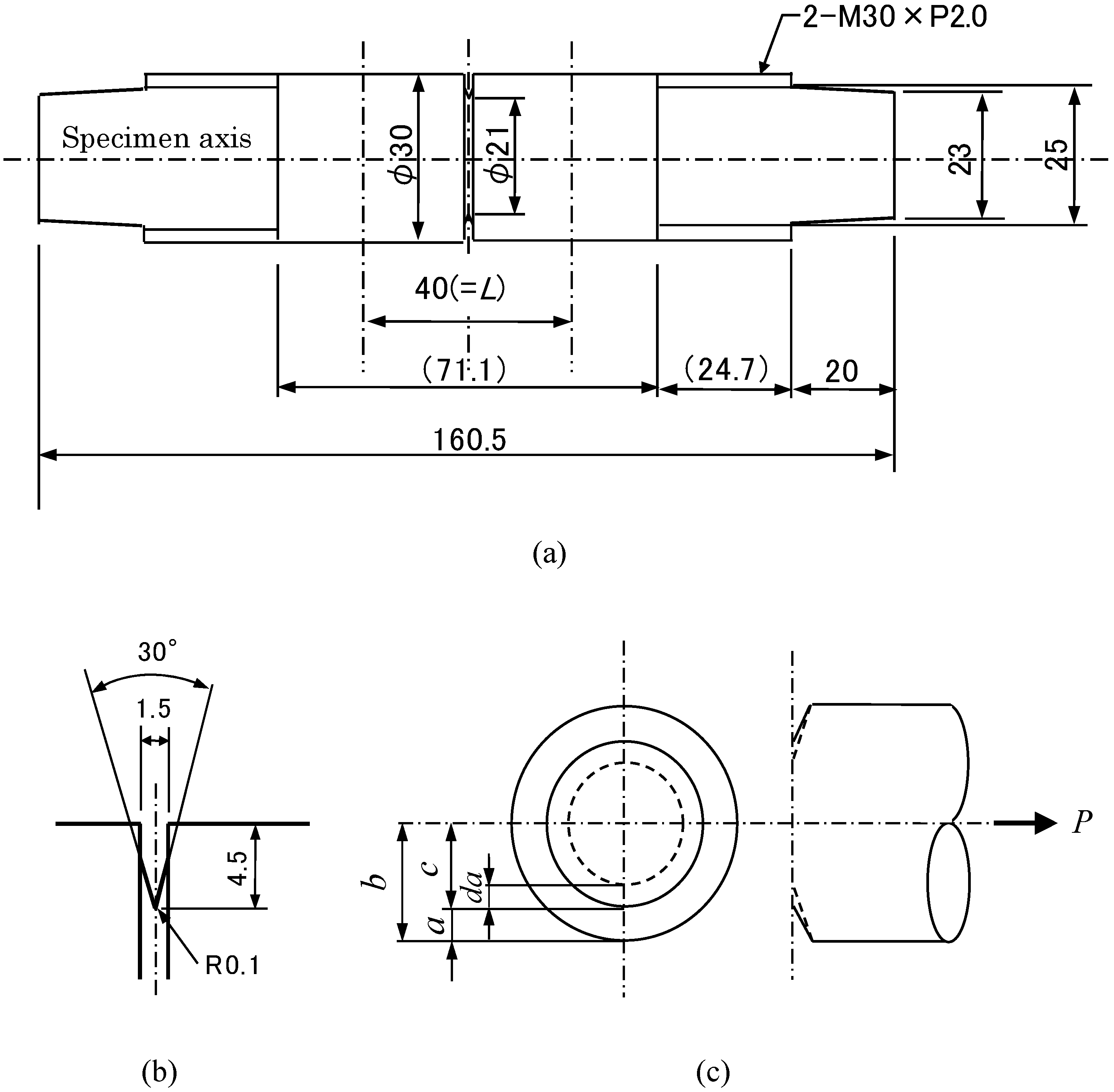
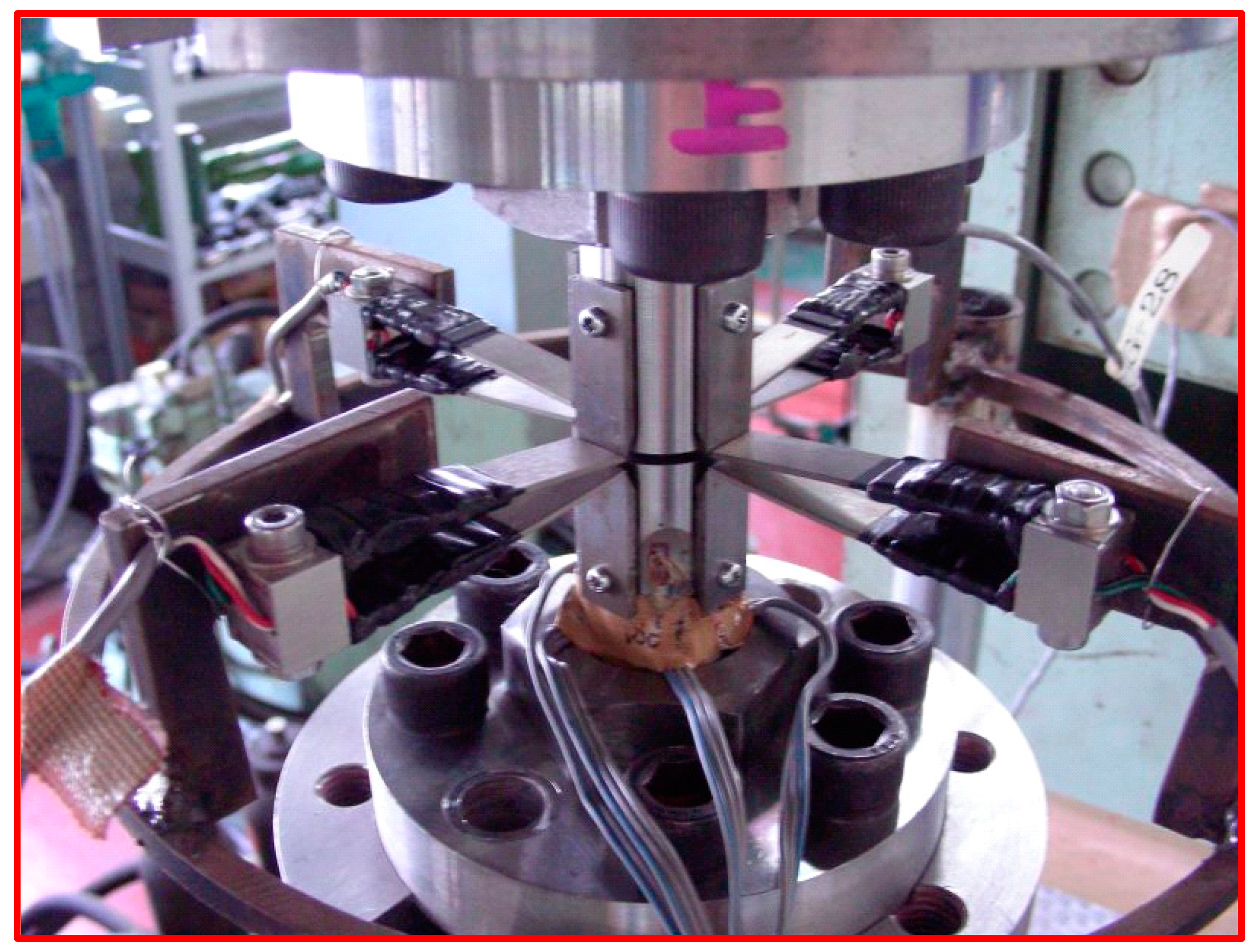
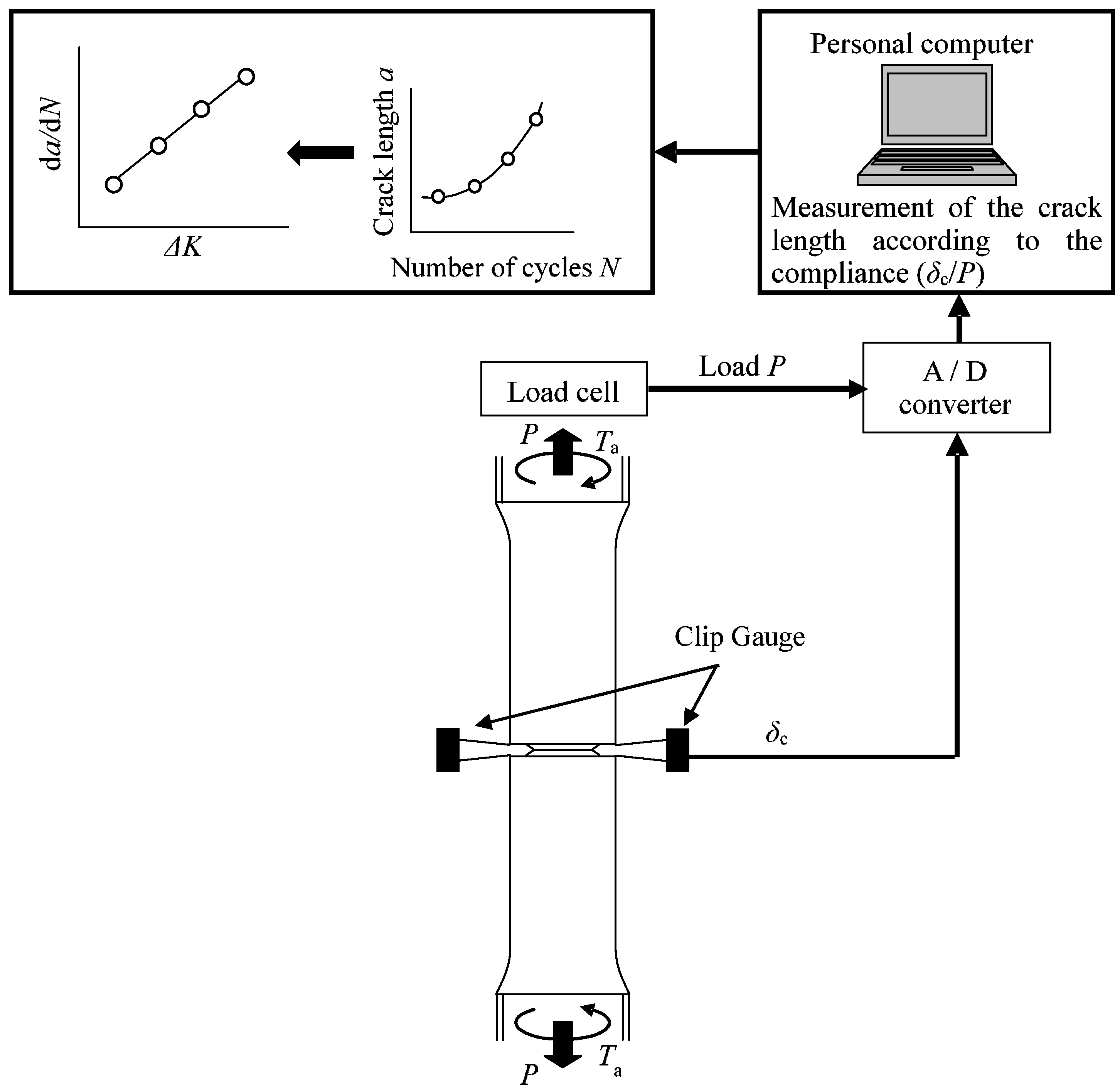
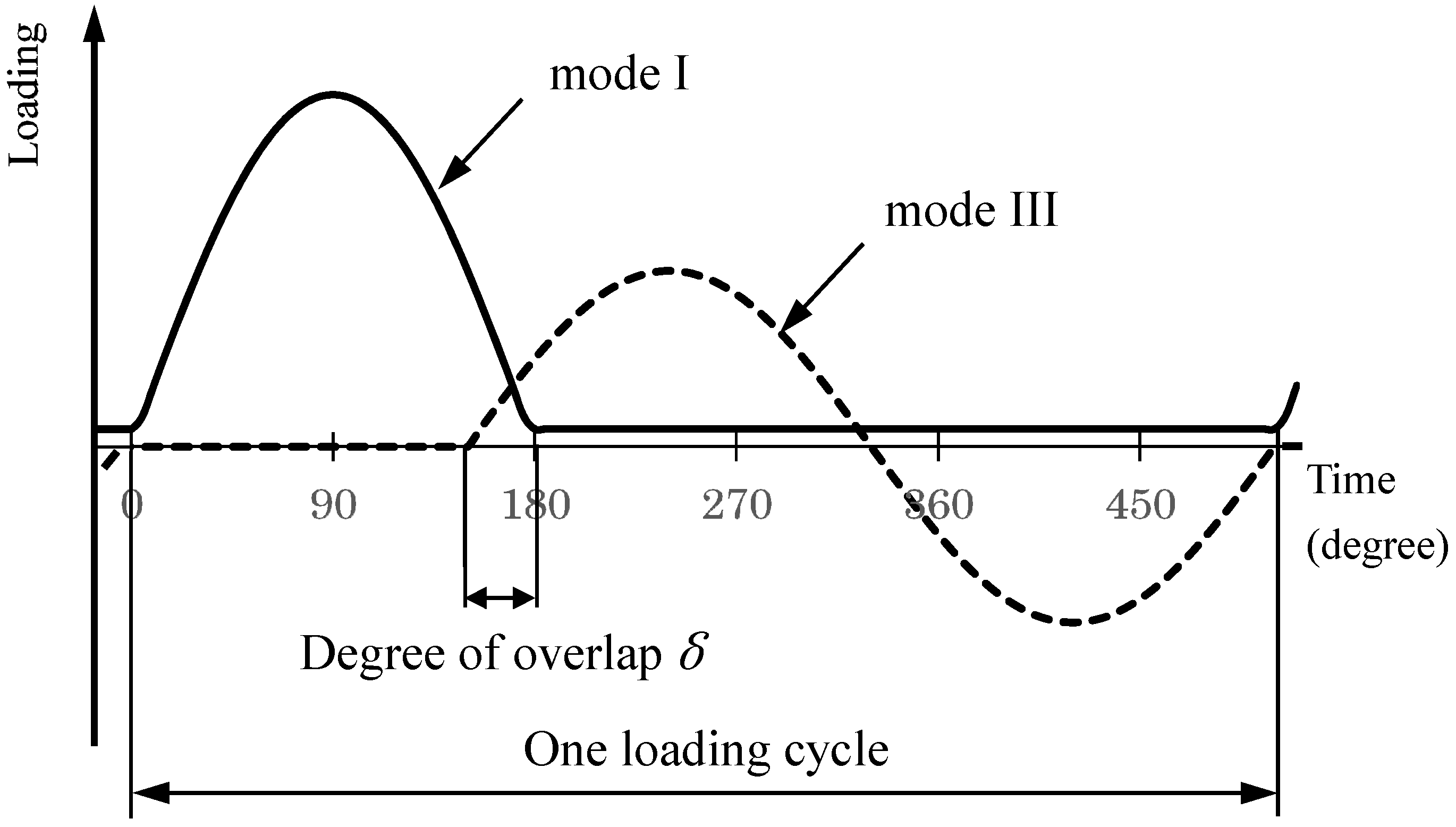
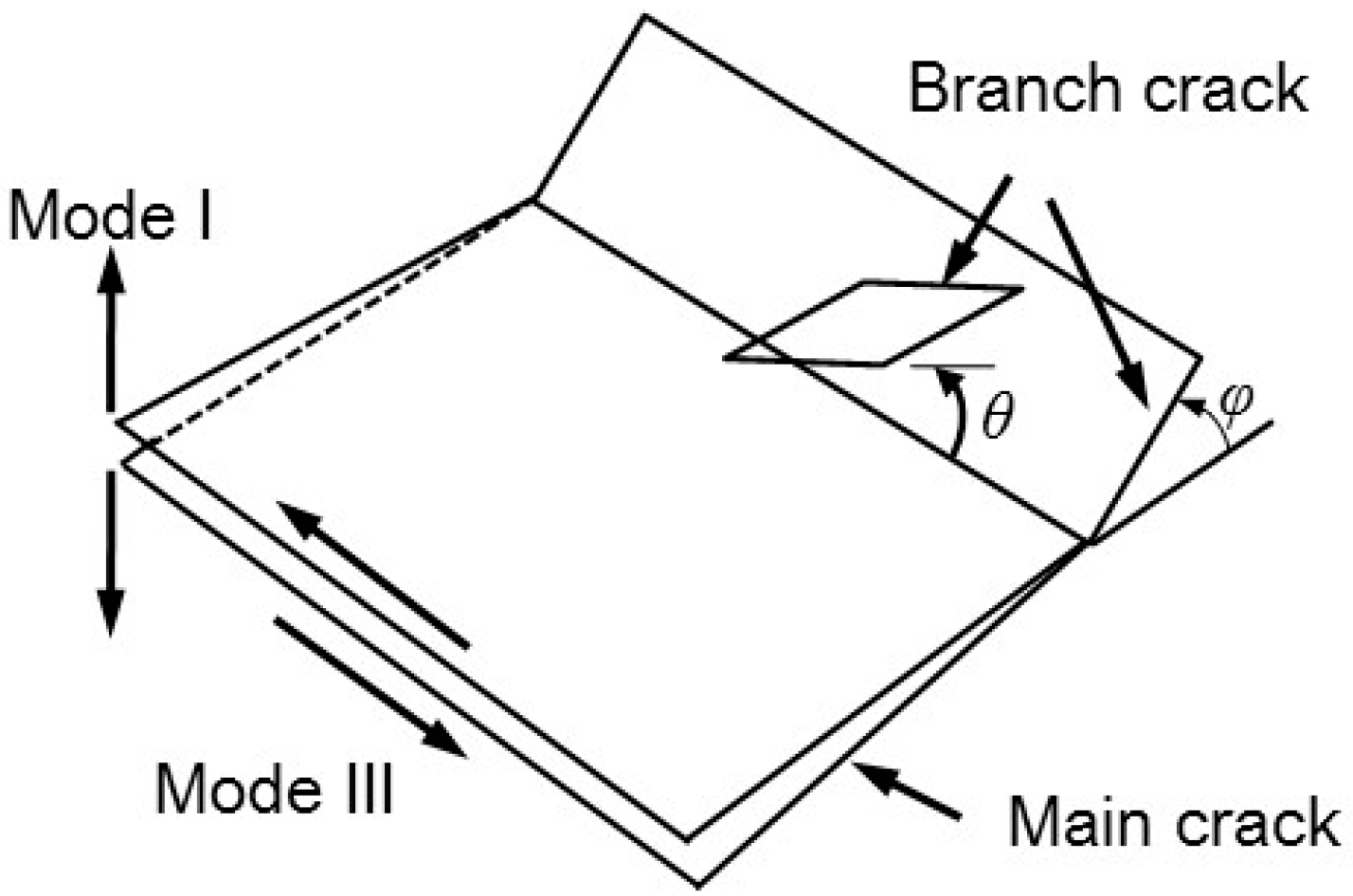

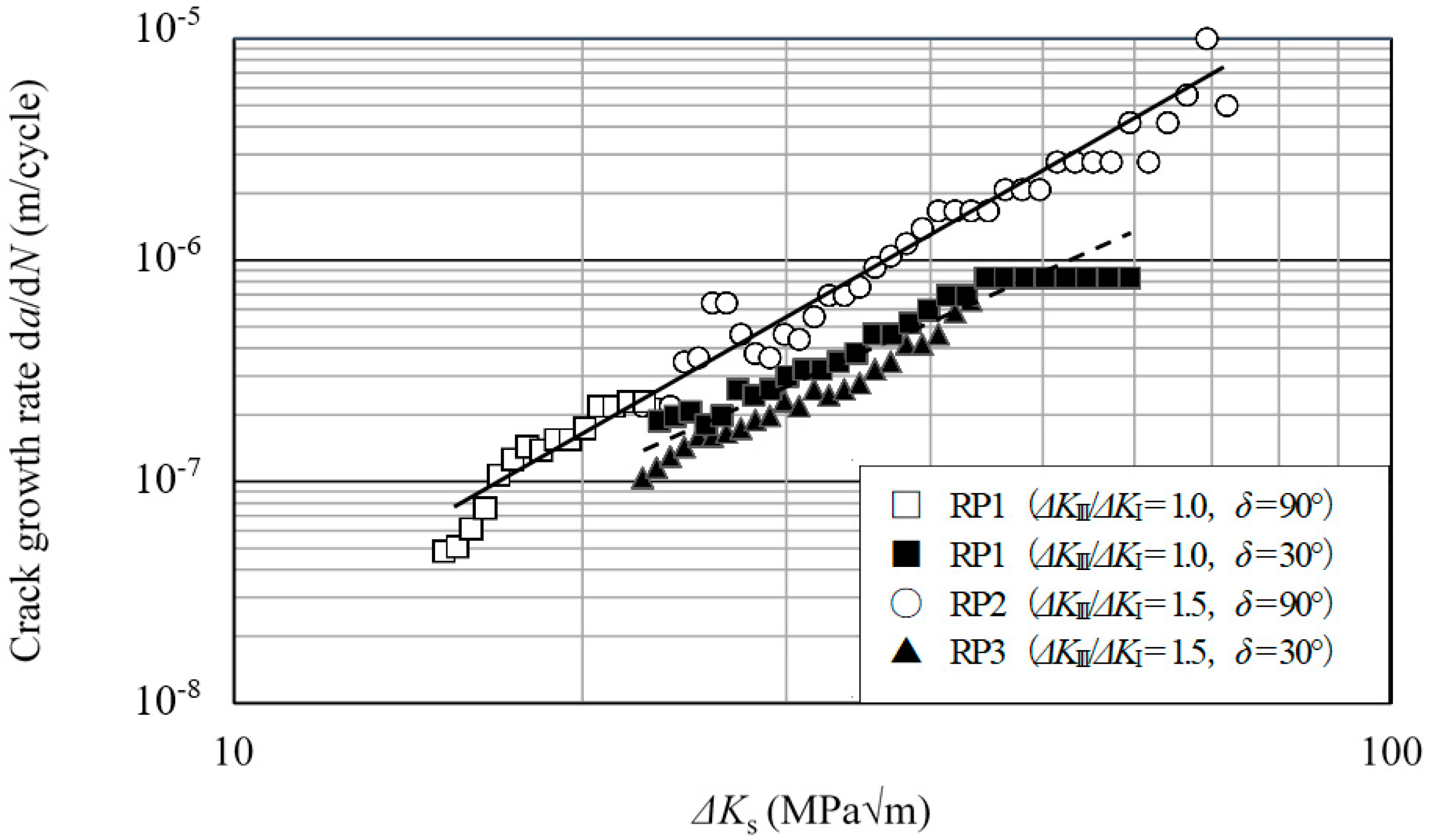
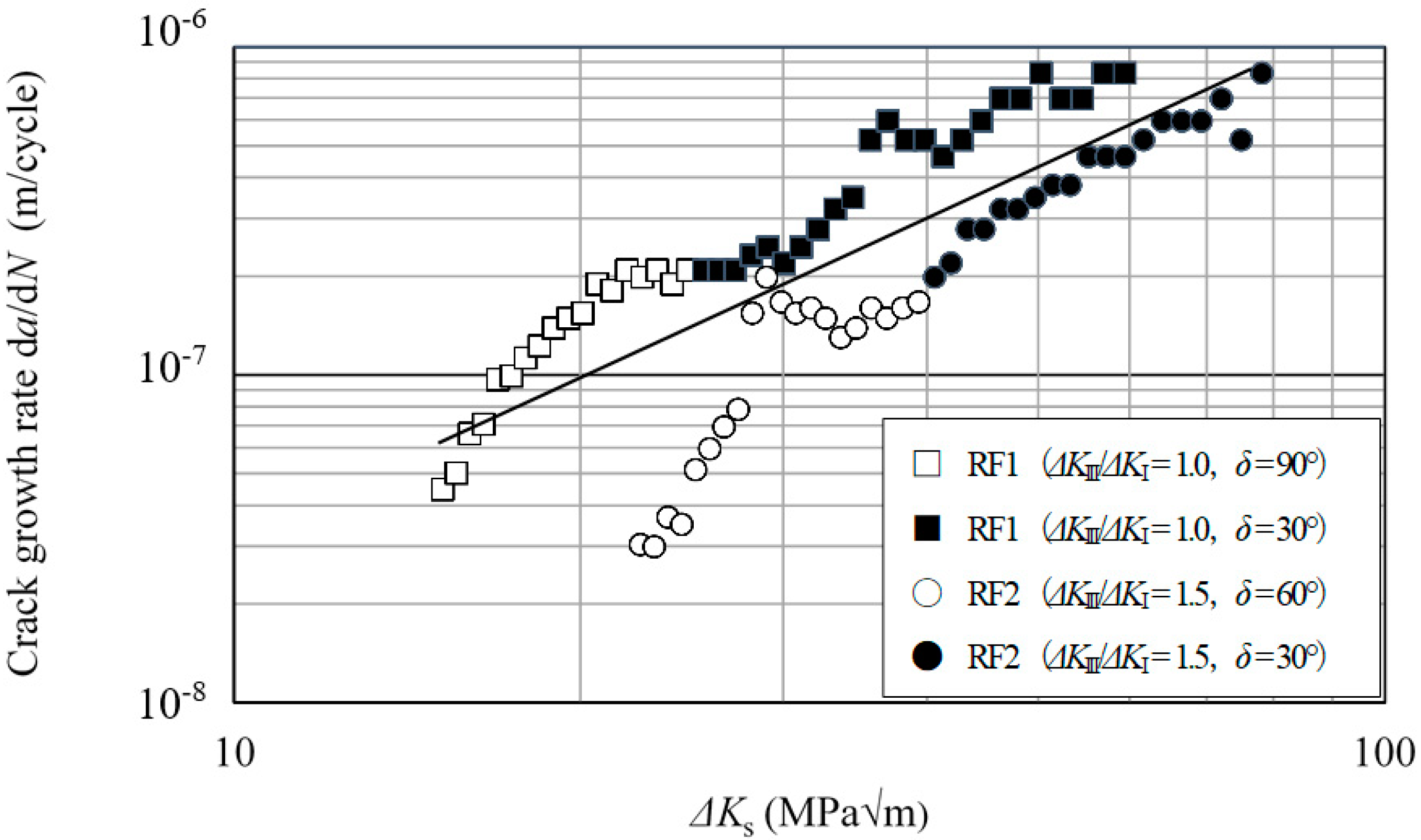
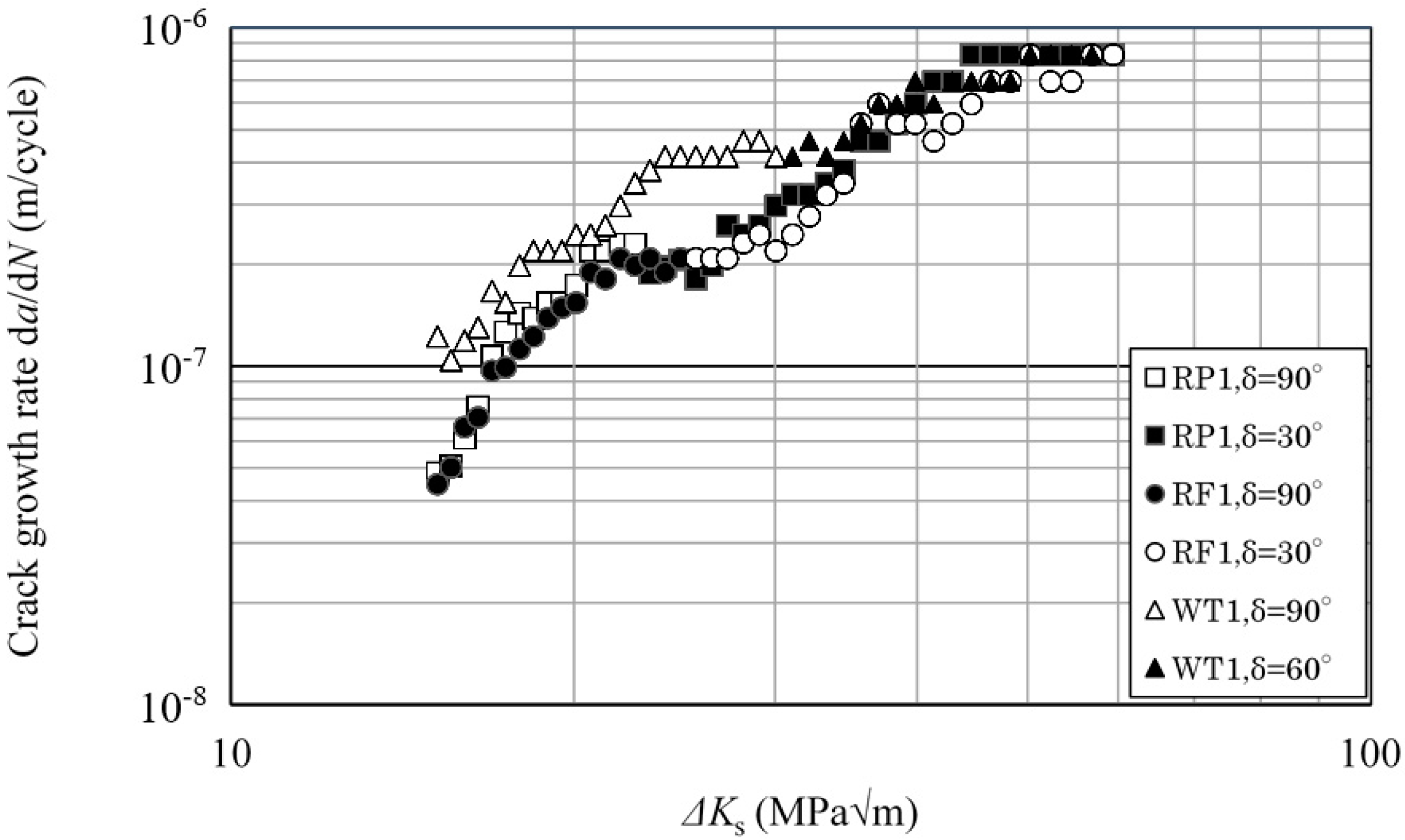
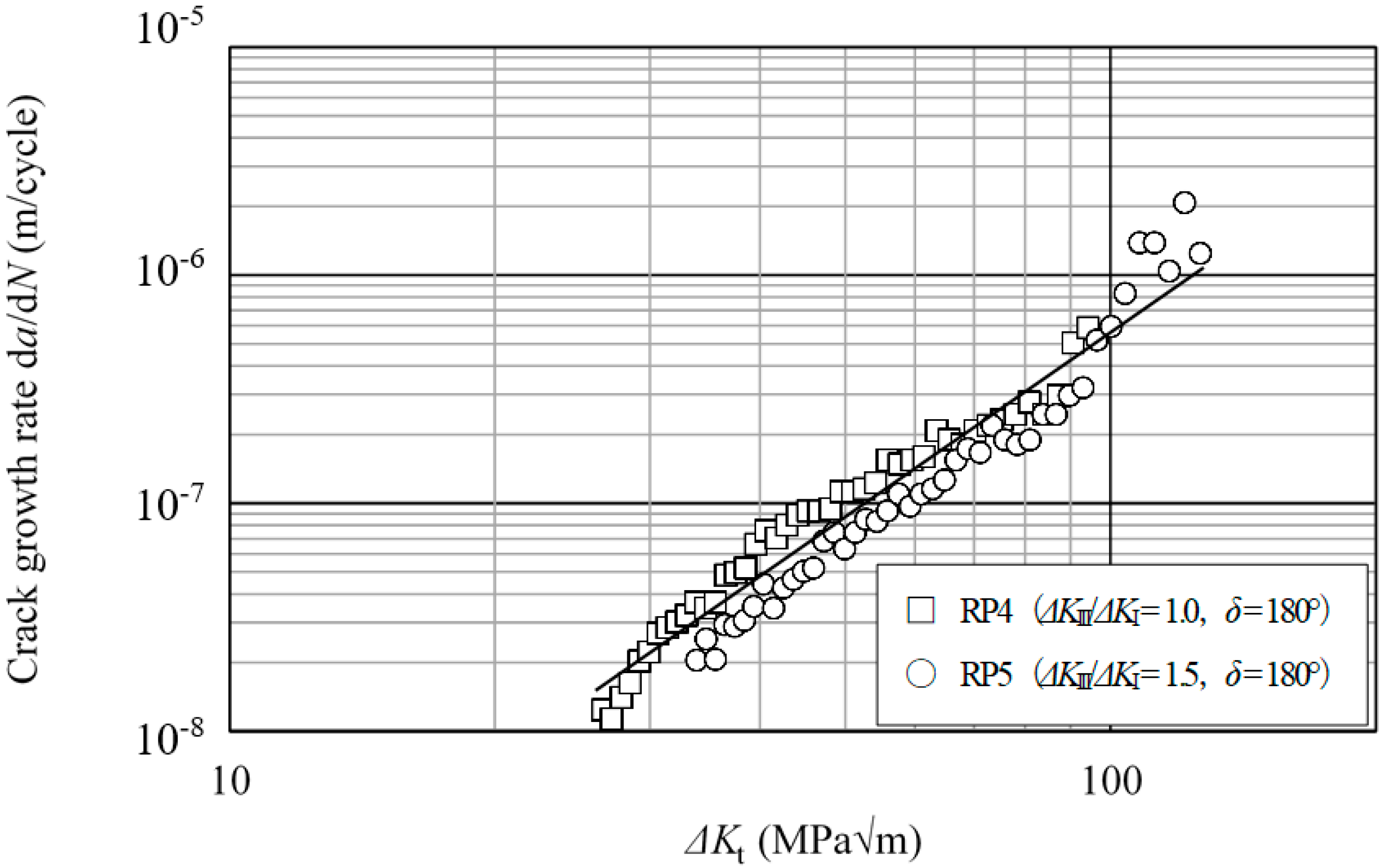
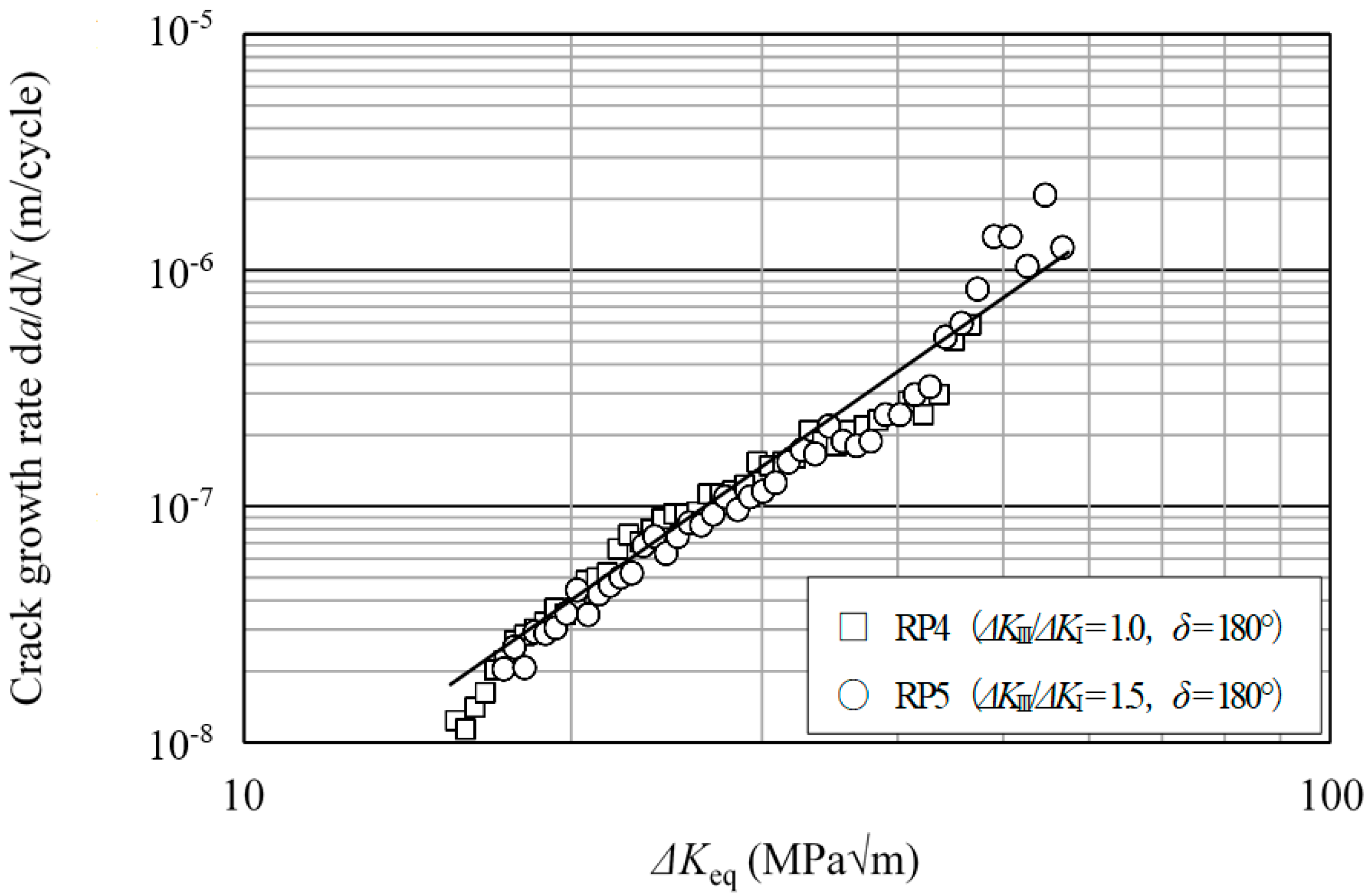
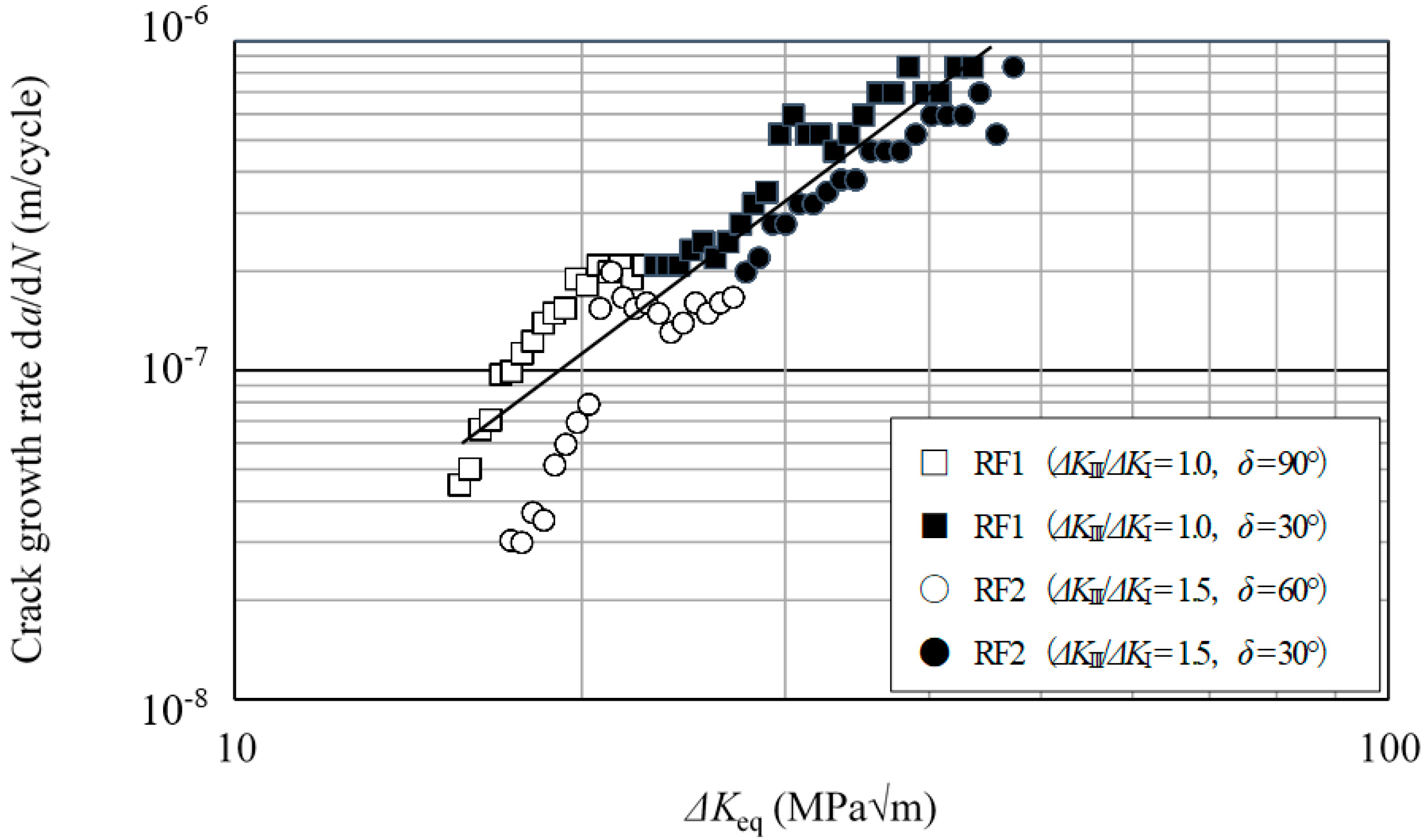

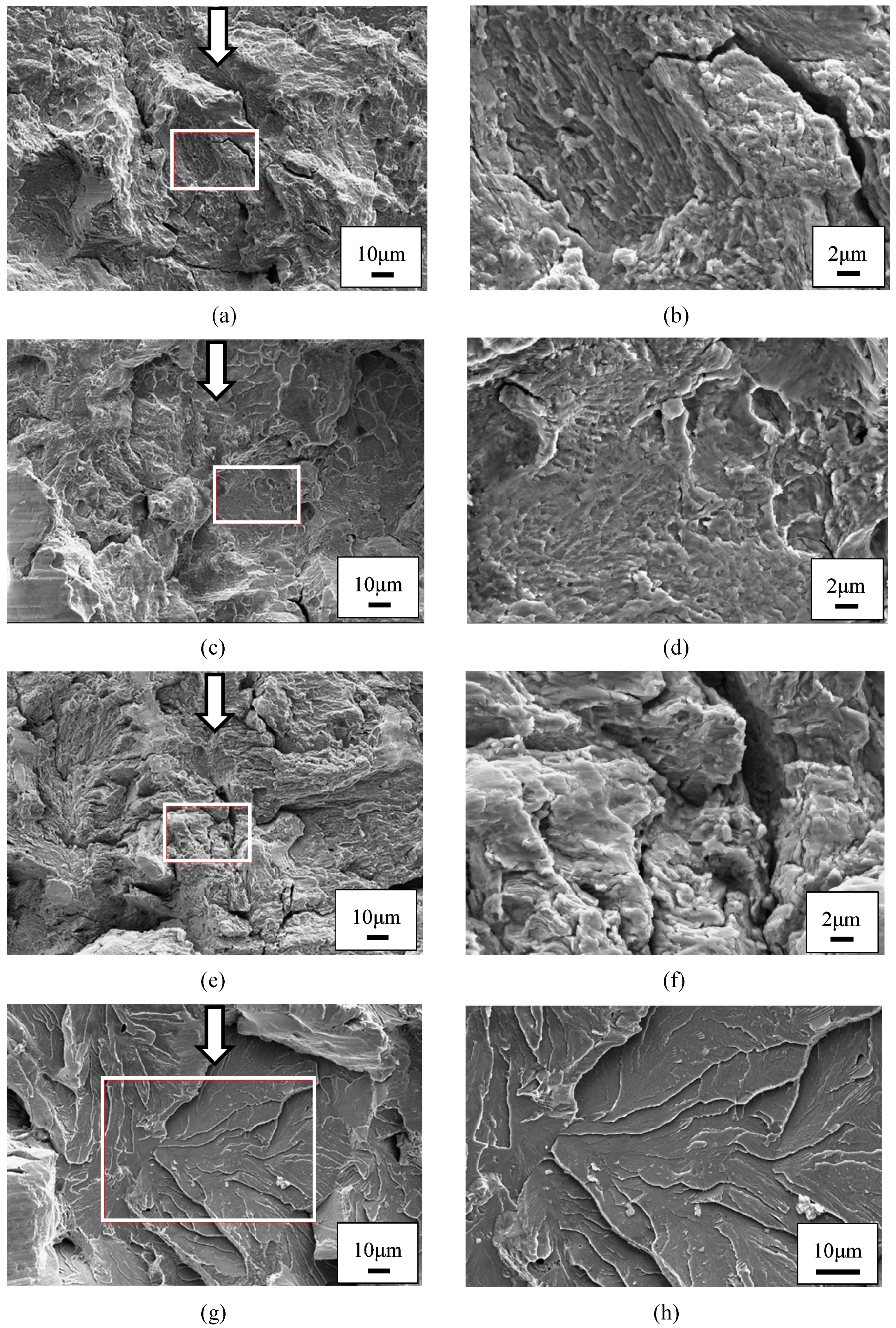
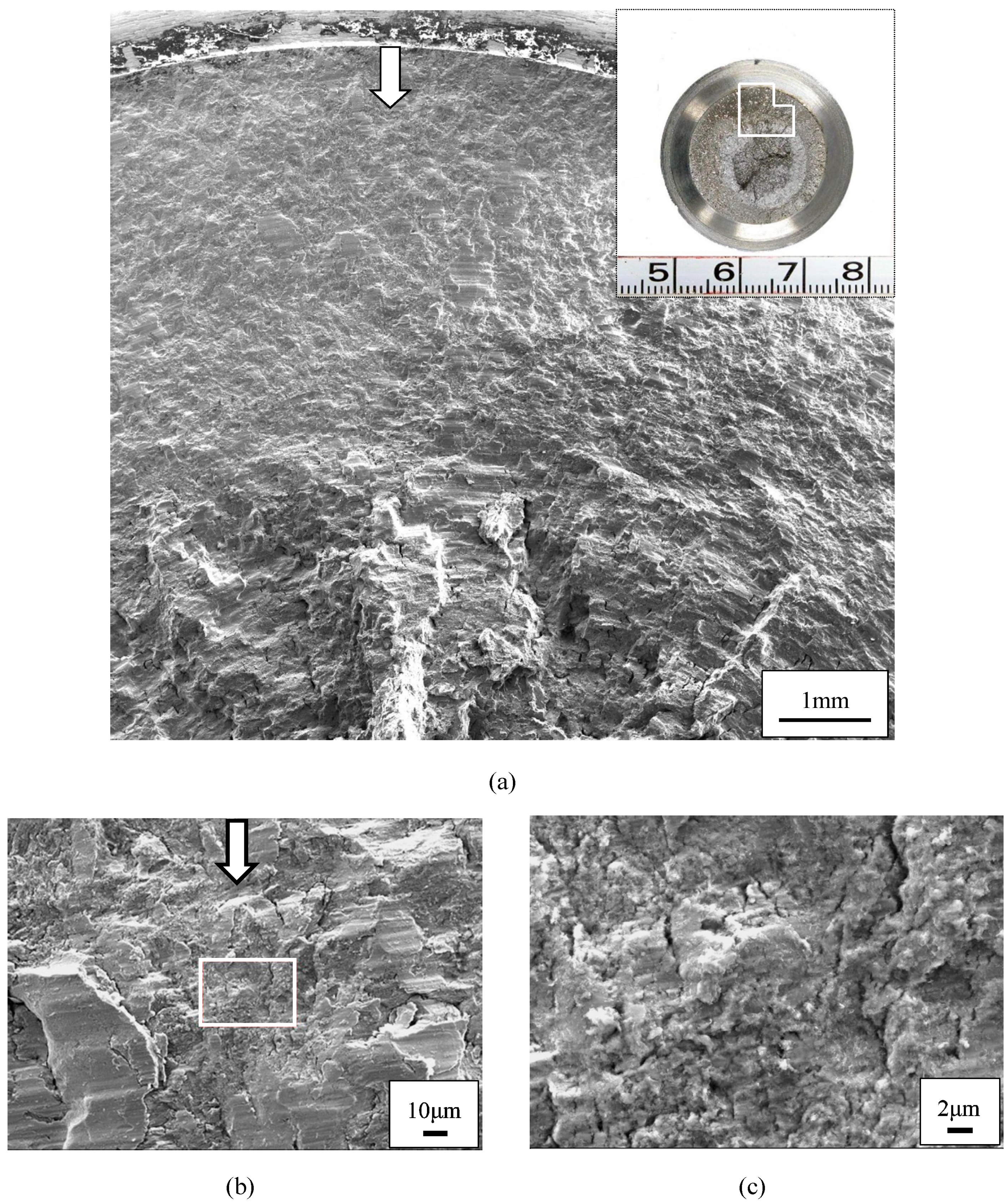
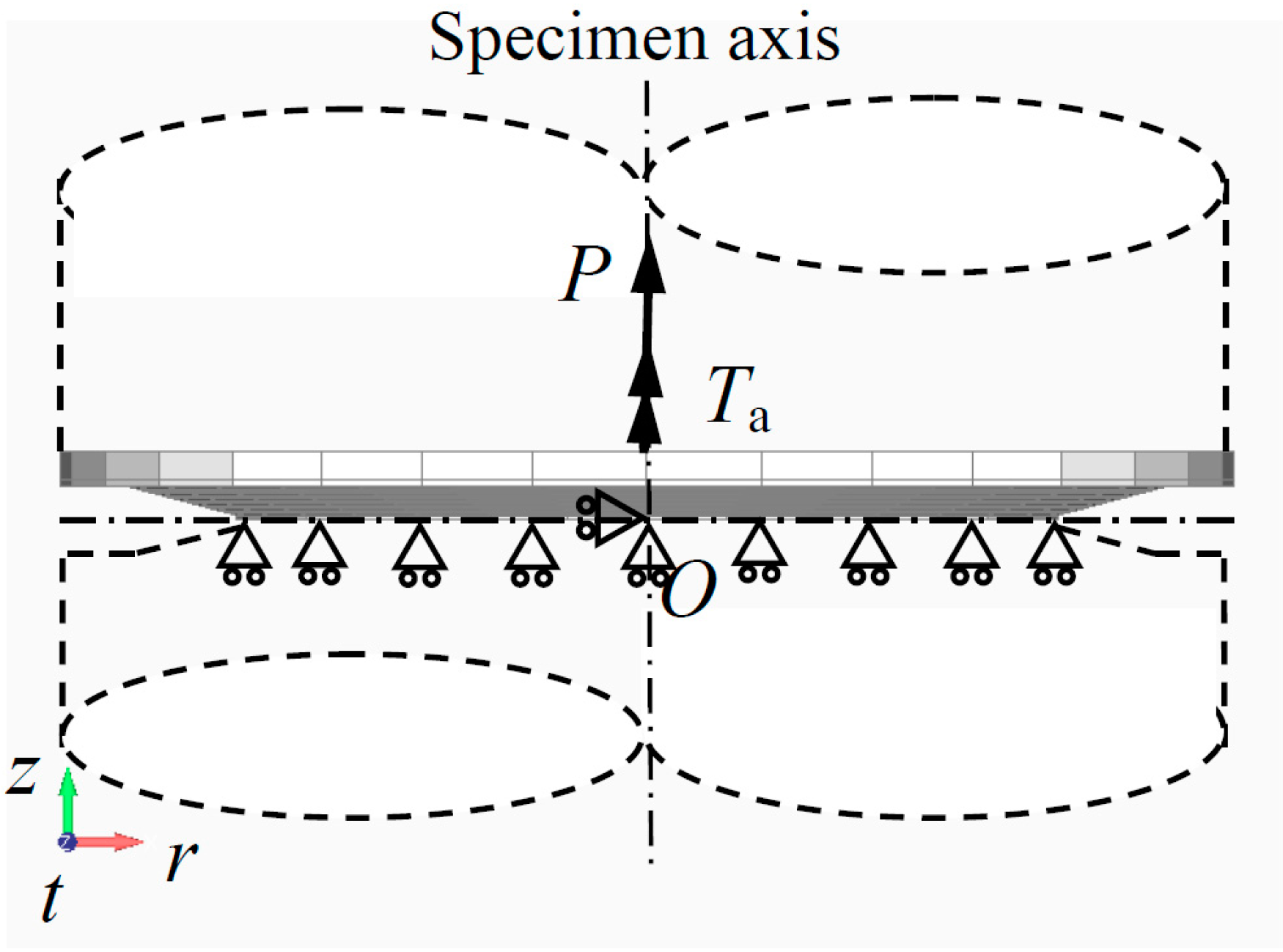
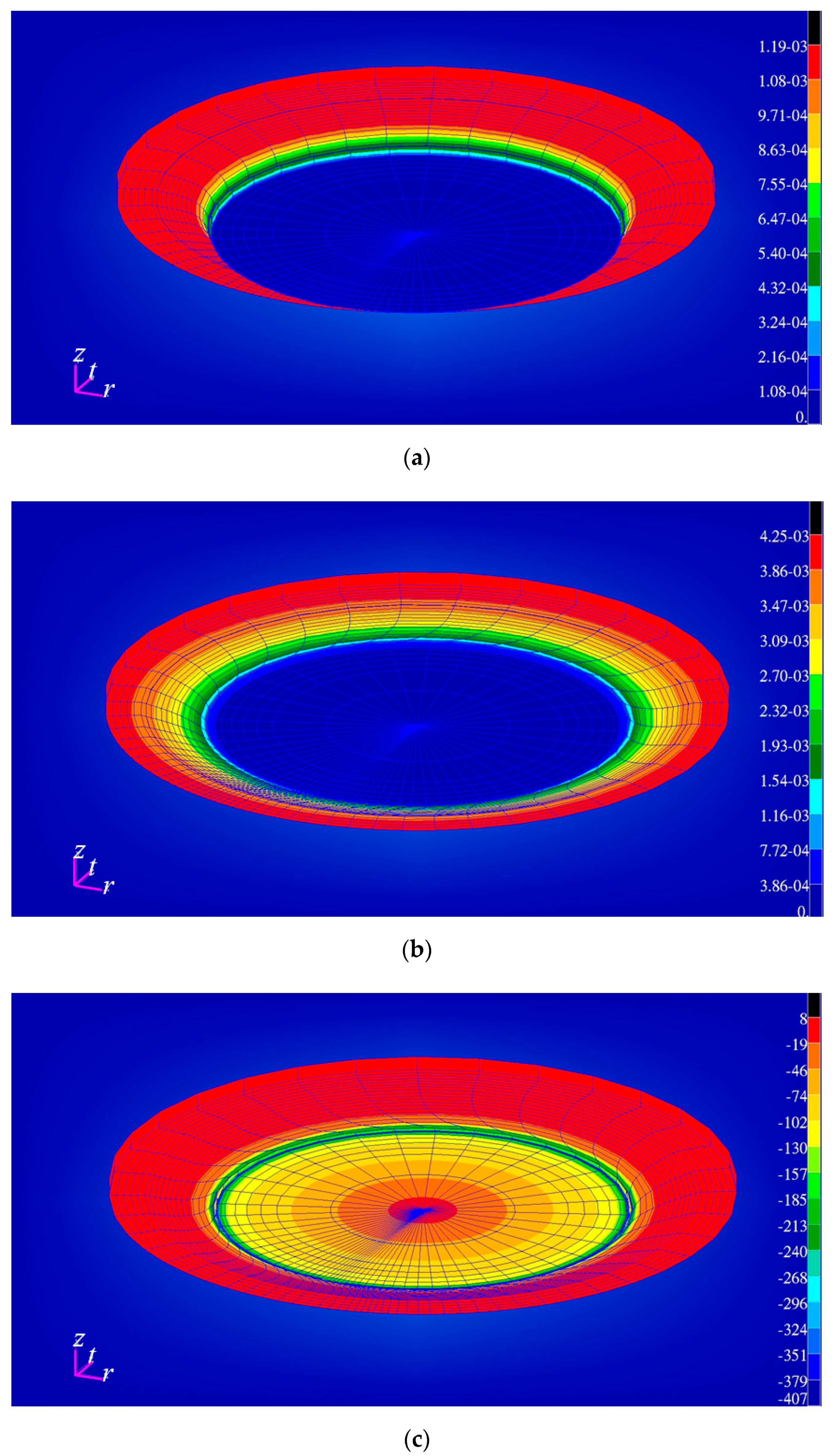
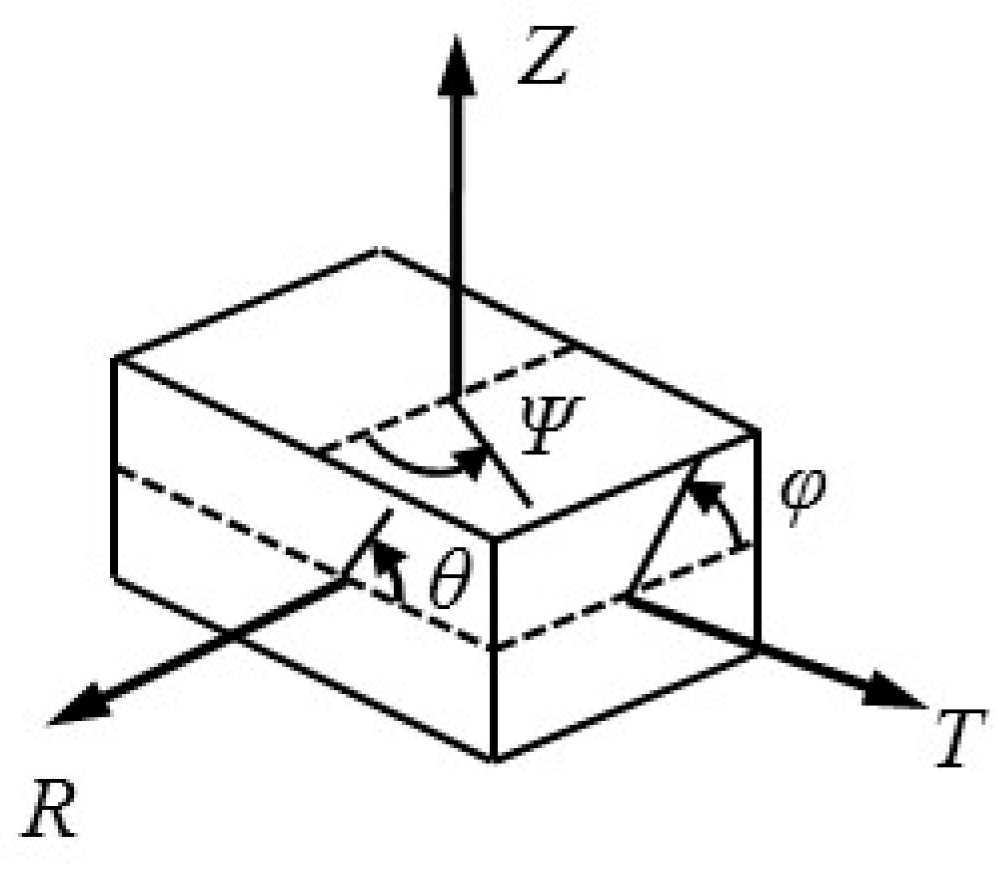
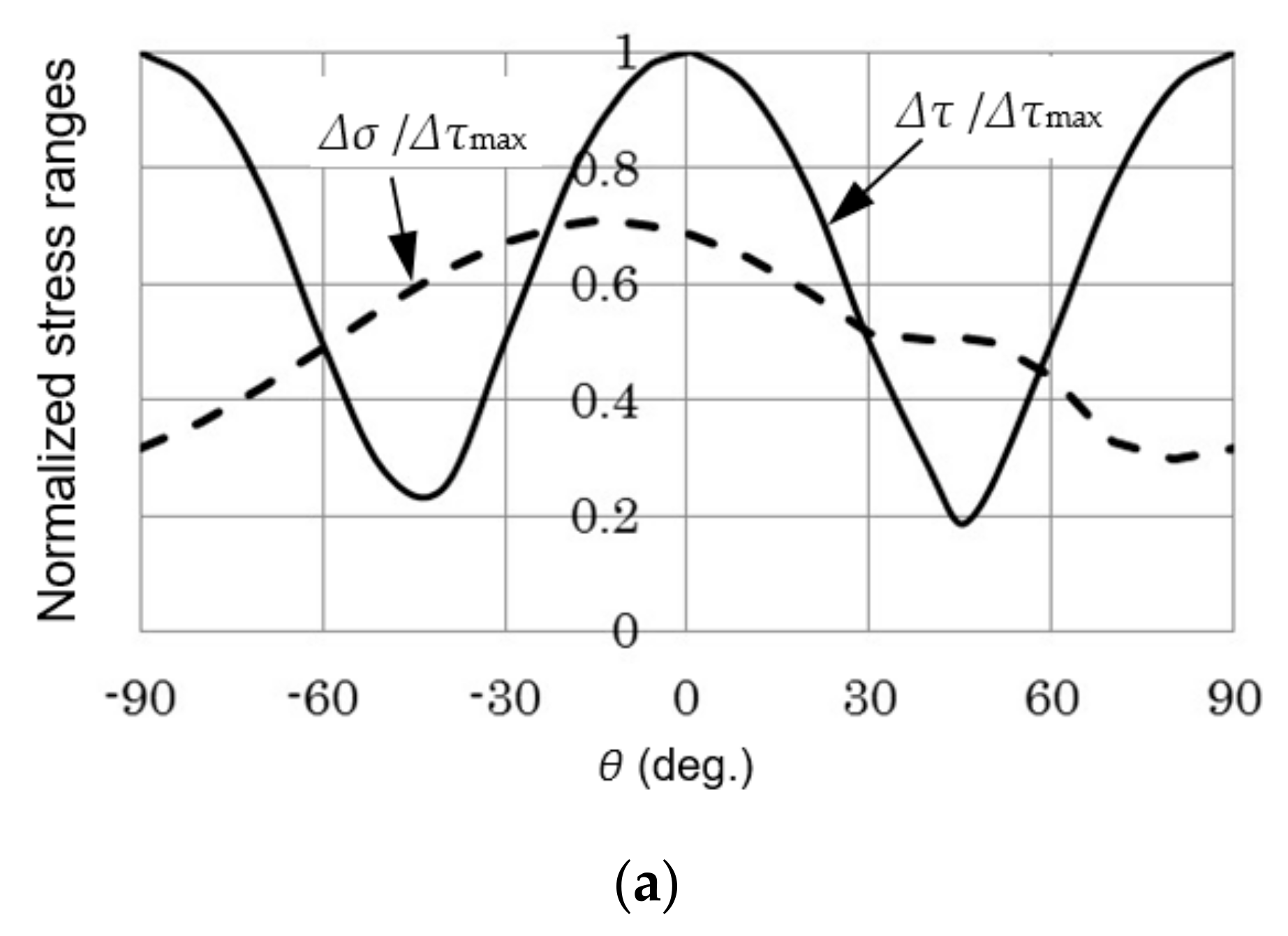

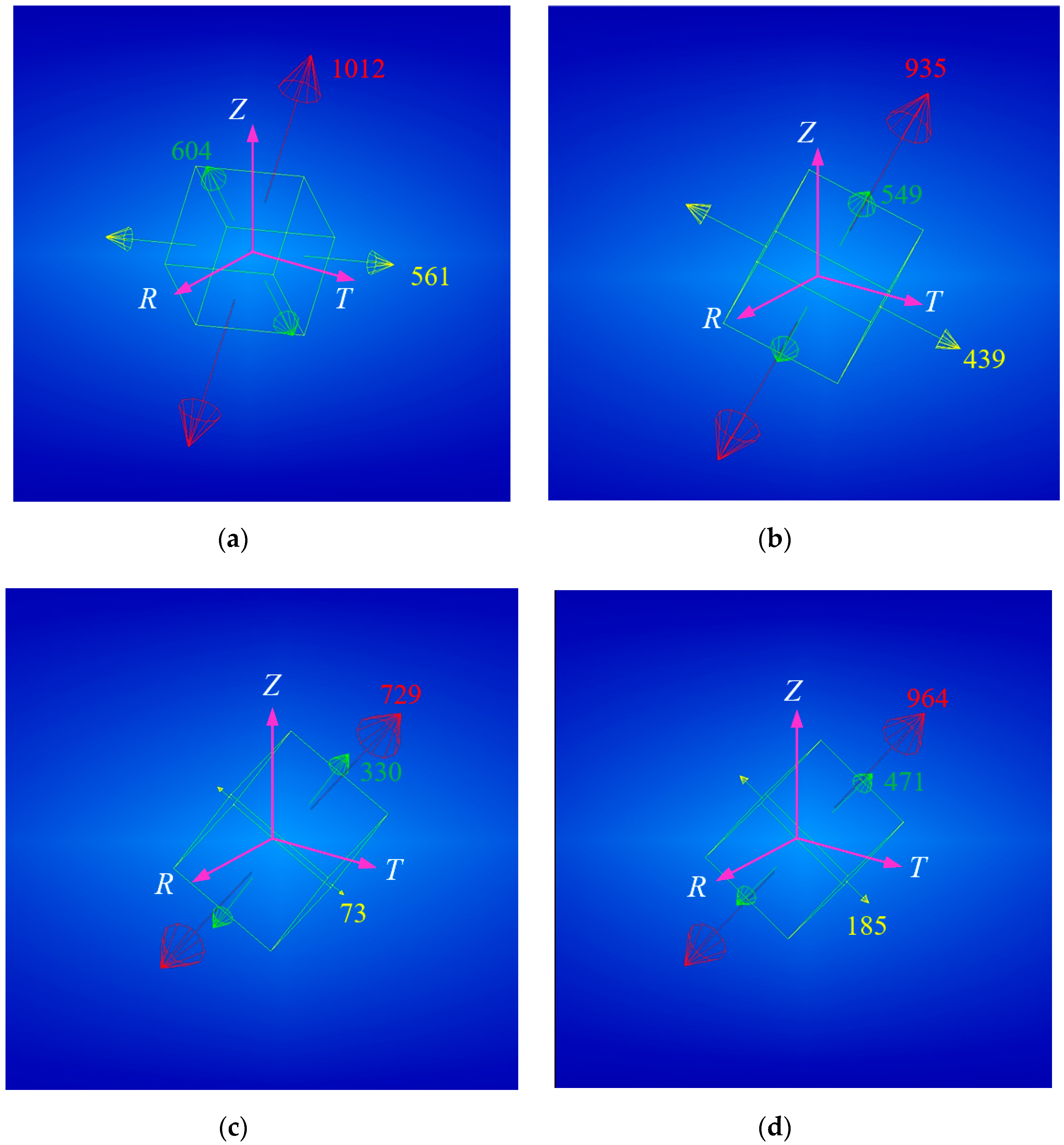
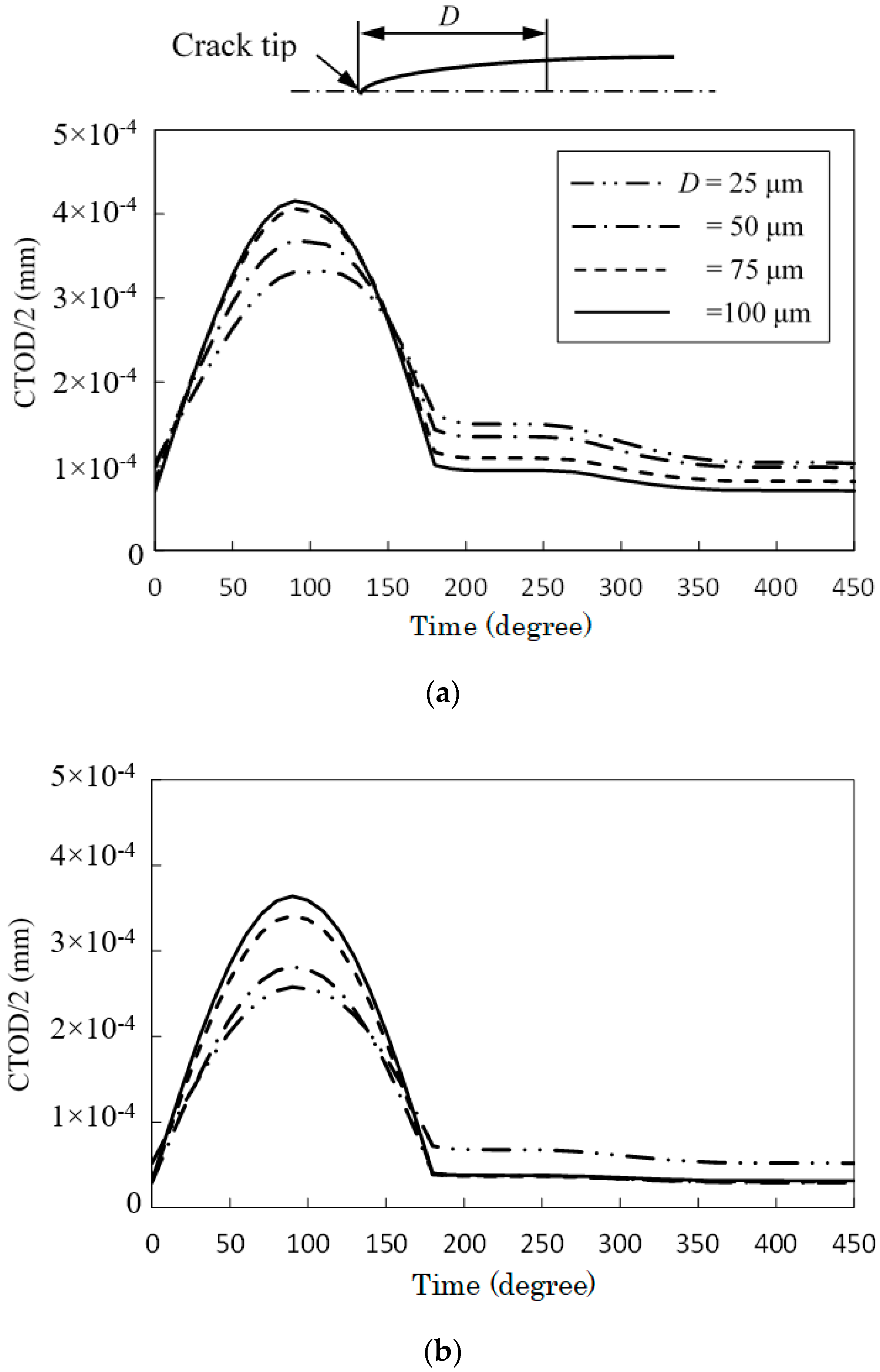
| Material | C | Si | Mn | P | S |
|---|---|---|---|---|---|
| Rail steel, RP | 0.68 | 0.26 | 0.93 | 0.016 | 0.01 |
| Rail steel, RF | 0.79 | 0.17 | 0.82 | 0.019 | 0.01 |
| Wheel steel, WT | 0.65 | 0.26 | 0.73 | 0.016 | 0.01 |
| Material | Ultimate Tensile Strength (MPa) | 0.2% Proof Stress (MPa) |
|---|---|---|
| Rail steel, RP | 934 | 511 |
| Rail steel, RF | 1214 | 802 |
| Wheel steel, WT | from 981 to 1030 | from 618 to 657 |
| Exp. No. | ΔKIII/ΔKI | Δ (degree) |
|---|---|---|
| RP1 | 1.0 | 90 → 30 |
| RP2 | 1.5 | 90 |
| RP3 | 1.5 | 30 → 120 |
| RP4 | 1.0 | 180 |
| RP5 | 1.5 | 180 |
| RF1 | 1.0 | 90 → 30 |
| RF2 | 1.5 | 60 → 30 |
| RF3 | 1.0 | 180 |
| WT1 | 1.0 | 90 → 60 |
| Material | E (MPa) | ν | 0σy (MPa) | Q | b | h (MPa) | ζ |
|---|---|---|---|---|---|---|---|
| RP | 183,008 | 0.3 | 508 | −208 | 24.2 | 85,248 | 193 |
| RF | 182,778 | 0.3 | 684 | −264 | 1.27 | 88,615 | 185 |
| δ(deg.) | 30 | 90 | 120 | 180 |
|---|---|---|---|---|
| θ(deg.) | −17 | −27 | −42 | −41 |
| φ(deg.) | −4 | −3 | 9 | 4 |
© 2019 by the authors. Licensee MDPI, Basel, Switzerland. This article is an open access article distributed under the terms and conditions of the Creative Commons Attribution (CC BY) license (http://creativecommons.org/licenses/by/4.0/).
Share and Cite
Akama, M.; Kiuchi, A. Fatigue Crack Growth under Non-Proportional Mixed Mode Loading in Rail and Wheel Steel Part 2: Sequential Mode I and Mode III Loading. Appl. Sci. 2019, 9, 2866. https://doi.org/10.3390/app9142866
Akama M, Kiuchi A. Fatigue Crack Growth under Non-Proportional Mixed Mode Loading in Rail and Wheel Steel Part 2: Sequential Mode I and Mode III Loading. Applied Sciences. 2019; 9(14):2866. https://doi.org/10.3390/app9142866
Chicago/Turabian StyleAkama, Makoto, and Akira Kiuchi. 2019. "Fatigue Crack Growth under Non-Proportional Mixed Mode Loading in Rail and Wheel Steel Part 2: Sequential Mode I and Mode III Loading" Applied Sciences 9, no. 14: 2866. https://doi.org/10.3390/app9142866
APA StyleAkama, M., & Kiuchi, A. (2019). Fatigue Crack Growth under Non-Proportional Mixed Mode Loading in Rail and Wheel Steel Part 2: Sequential Mode I and Mode III Loading. Applied Sciences, 9(14), 2866. https://doi.org/10.3390/app9142866




